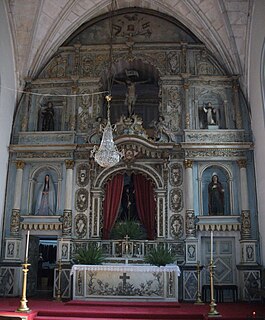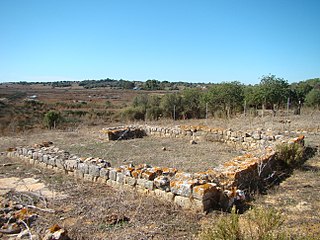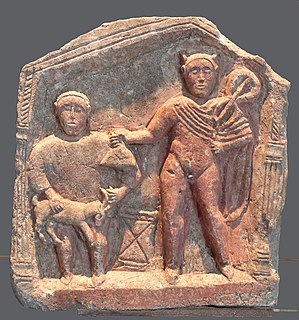
Braga is a city and a municipality in the northwestern Portuguese district of Braga, in the historical and cultural Minho Province. The city has a resident population of 192,494 inhabitants, representing the seventh largest municipality in Portugal. Its area is 183.40 km². Its agglomerated urban area extends from the Cávado River to the Este River. It is the third-largest urban centre in Portugal

Nelas is a municipality located in the Centro Region of continental Portugal. The population in 2011 was 14,037, in an area of 125.71 km².

Municipium Cives Romanorum Felicitas Julia Olisipo was the ancient name of modern-day Lisbon while part of the Roman Empire.

Balsa was a Roman coastal town in the province of Lusitania, Conventus Pacensis.

The Roman Ruins of Cerro da Vila are the remnants of a historical villa in the Algarve region of southern Portugal. Its vestiges lie in the vicinity of the resort and marina of Vilamoura, in the civil parish of Quarteira, municipality of Loulé Municipality.

The Roman ruins of Casais Velhos are the remains of a Roman town, in the municipality of Cascais, lisbon District, Portugal that included baths, two cemeteries, remains of a wall and ceramic artifacts.

The Roman villa of Alto da Cidreira is a Roman villa in the civil parish of Alcabideche, municipality of Cascais, in the Lisbon District of Portugal. Although known since the 1890s, this site has largely been neglected by archaeologists, resulting in destruction of artefacts, including Roman era mosaics, a bath complex and an olive oil cellar.
The Castro of Sacóias is former fortified settlement and archeological site in the civil parish of Baçal, municipality of Bragança in the Alto Trás-os-Montes subregion of the Portuguese Norte Region.

The Castle of the Moors is a hilltop medieval castle located in the central Portuguese civil parish of Santa Maria e São Miguel, in the municipality of Sintra, about 25km northwest of Lisbon. Built by the Berbers (Moors) in the 8th and 9th centuries, it was an important strategic point during the Reconquista, and was taken by Christian forces after the fall of Lisbon in 1147. It is classified as a National Monument, part of the Sintra Cultural Landscape, a UNESCO World Heritage Site.

The Chapel of D. Fradique is a chapel located in the Convent of São Francisco, in the civil parish of Estremoz, in the municipality of Estremoz, in the Portuguese district of Évora.
The Prehistoric Rock-Art Site Pala Pinta is a Paleolithic-era rock-art site, recognized for cave paintings in the Portuguese municipality of Alijó, in the civil parish of Carlão e Amieiro.
The Castle of Mau Vizinho is a medieval castle situated in the civil parish of Cimo de Vila da Castanheira, in the municipality of Chaves, district of Vila Real. Also referred to as the Castle of Moors, it is literally translated as the Castle of the Bad Neighbour
The Arcaheological site of Quinta dos Patudos is archaeological site in the civil parish of Alpiarça, in the municipality of the same name in the Portuguese district of Santarém. Sometimes referred to as the "castle" of Alpiarça, it is part of an archeological station within the Quinta dos Patudos, that includes the Castle of Alpiarça, Cabeço da Bruxinha, Necropolis of Tanchoal and the Necropolis of Meijão.

The Former Cathedral of Idanha-a-Velha is a medieval the decommissioned Catholic cathedral of the former bishopric of Egitânia, in the Freguesia of Monsanto e Idanha-a-Velha, in the municipality of Idanha-a-Nova, in the central Portuguese district of Castelo Branco.

The Castro of Monte Mozinho is a Neolithic fortified settlement, sometimes referred to as the City of the Dead, situated in the civil parish of Oldrões, in the municipality of Penafiel in the Tâmega Subregion of the Portuguese district of Porto.
The Castro of Monte Castelo is a Calcolithic fortified settlement, situated in the civil parish of Custóias, Leça do Balio e Guifões, in the municipality of Matosinhos in the northern Portuguese district of Porto.

Sebastião Phillipes Martins Estácio da Veiga, was a Portuguese archeologist and writer, known for having discovered several important archaeological sites in the Algarve and having made advancements in the study of several others also found in the region and in the Alentejo.

Abicada is the name of Roman ruins north of the municipality of Alvor, in Roman times the colony of Ipses, which was authorized to mint currency, and near Mexilhoeira Grande in the district of Portimão, Algarve, Portugal and where Pompeia Exoce looked after the burial of her grandson. Both were in the Roman province of Lusitania. Portimão, known as Portus Magnus, was an important Roman commercial port when the Villa was built.

Barragem Romana da Fonte Coberta, the Roman Dam of the Covered Fountain is situated in the parish of São Sebastião in the municipality of Lagos, in Portugal .The dam was constructed during the Romanization of Hispania.
























